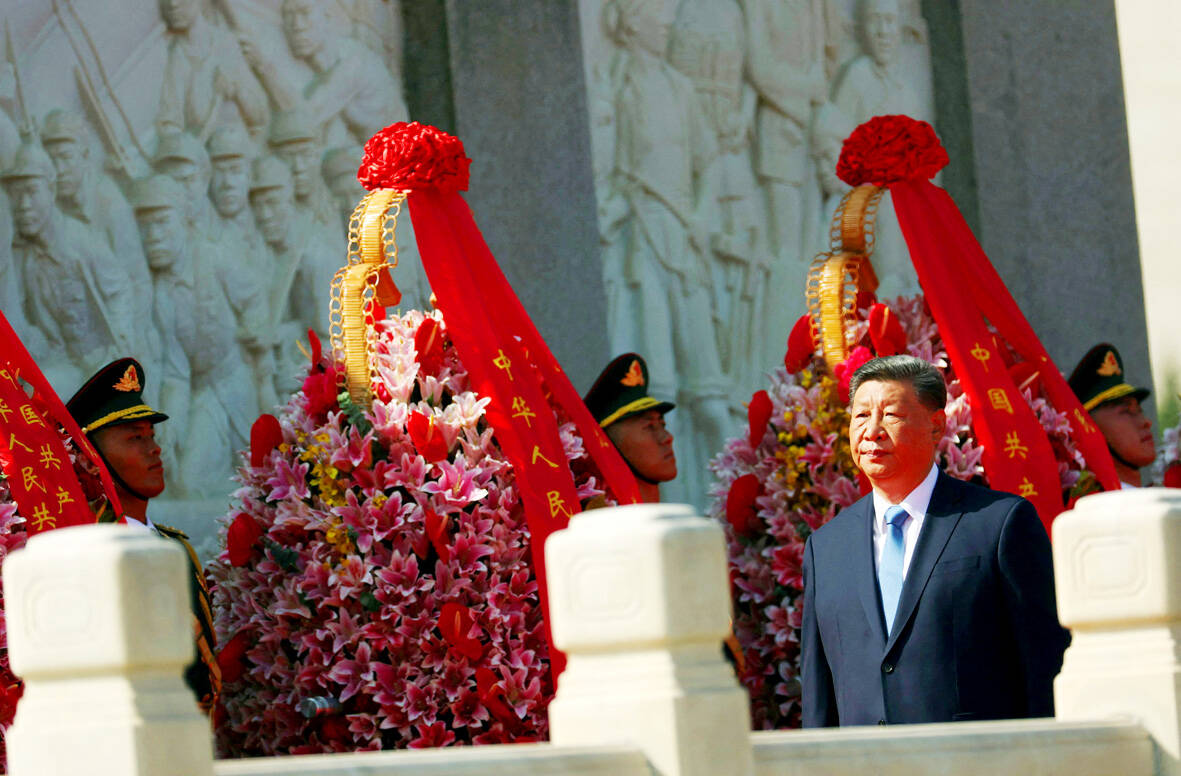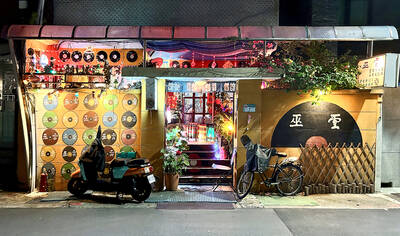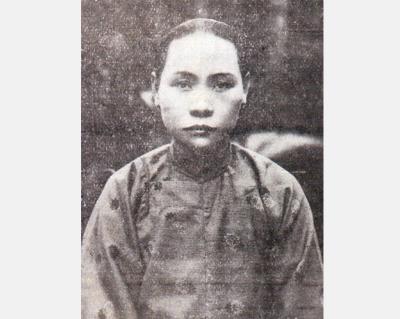The Chinese Communist Party (CCP) has a dystopian, radical and dangerous conception of itself.
Few are aware of this very fundamental difference between how they view power and how the rest of the world does. Even those of us who have lived in China sometimes fall back into the trap of viewing it through the lens of the power relationships common throughout the rest of the world, instead of understanding the CCP as it conceives of itself.
Broadly speaking, the concepts of the people, race, culture, civilization, nation, government and religion are separate, though often overlapping and intertwined.

Photo: AFP
A government is expected to represent a country, the nation or nations within it, and the interests of its people, informed by their unique cultures, civilizations, economies and religions. With few exceptions, people conceive of their governments as more or less expected to fit within those guidelines, and even the worst governments have some forces they accept are outside of their power, try as they might to co-opt them.
Kings and emperors can lose their divine right to rule or the mandate of heaven, overbearing theocracies can be toppled by secular forces, insufficiently pious governments can be toppled by religious forces and rapacious military dictatorships can crumble when the rank-and-file soldiers lose loyalty to a government they feel no longer represents the nation.
In one-party states, where the lines between party and state become blurred, there remains no question that it is the government that holds the power, regardless of how dominant the party’s control over it may be — and parties can ultimately be thrown out of power and replaced.

Photo: AP
In the Soviet Union, the communists seized power, purged their enemies and created a one-party state; however, ultimately it was still the state that wielded power, even if party members filled all positions of power. They may have subverted whole swathes of society, but they were still partially constrained by the power relationships that other countries were.
GOVERNMENT BY AND FOR THE CCP
The CCP completely upended all relationships from the ground up.
The People’s Republic of China (PRC) was created by and for the CCP, and is constitutionally subordinate to the party. Everything the government does is to serve the interests of the CCP, not the people, not the nation, not the country.
High-level government positions are window dressing unless the person also holds a similarly high-ranking position within the CCP. For example, there is little point in the defense minister of a nation meeting their nominal counterpart defense minister of the PRC, unless that person holds a similarly high-ranking position on the CCP’s Central Military Commission (CMC).
The absurdity of the role of defense minister of the PRC is summed up on the ministry’s Web site: “The Central Military Commission (CMC) takes charge of the overall administration of China’s armed forces.”
The PRC has no military because it’s controlled by the CCP.
The People’s Liberation Army (PLA) is the armed wing of the CCP. It does not defend or serve the nation, the state or the people — it serves to defend the CCP and its interests.
Even more absurd, the PLA was established by the CCP to battle the nationalist Republic of China (ROC) armed forces, which fled to Taiwan after losing the Chinese Civil War in 1949.
On paper, that means the standing armed forces of the Chinese nation are in Taiwan, and today stand guard against an invasion by “China” in the form of the CCP’s armed wing. This bizarre state of affairs remains a problem for Taiwan’s military today, creating confusing loyalties that the CCP is sometimes able to exploit.
ALL MINE!
As far as the CCP is concerned, they own everything within their claimed territory and much beyond it.
Mao Zedong (毛澤東) was explicit about this, and forced people into communal living arrangements with no personal property, though they might tolerate some personal effects. Yay, my Mao button is all mine!
That fundamentally has not changed. Deng Xiaoping (鄧小平) realized how economically destructive Mao’s policies were, and rapidly expanded tolerance for what people would be allowed to possess and utilize for their own benefit.
This was only a provisional reform, and current CCP leader Xi Jinping (習近平) has rolled back some of those reforms, effectively reminding people of just how tenuous their “ownership” of anything is.
There is no individual property, only long-term leases of varying durations. Financial transactions are done through CCP-owned or controlled banks and financial institutions, increasingly through carefully controlled and monitored apps.
Whenever they want, the CCP can seize anything and everything a person owns. One can protest to the government, but as a wholly-owned subsidiary of the CCP, it will do whatever it is ordered to do.
The most effective recourse is to bribe one CCP official to overrule another, but that only works for small, non-ideological problems.
This ensures that the people are effectively owned by the CCP. Technically, they are not, but good luck finding food, water, and shelter outside of the CCP system.
THE CCP’S ‘CHINESE NATION’
Not only are the people effectively owned by the CCP, their identities, cultures, religions, languages and ethnicities are defined, developed and controlled by the CCP to “foster a strong sense of community for the Chinese nation,” according to the CCP constitution.
In practice, this means being subsumed into the dominant Han Chinese culture and race. Cultures, languages and religions are being systematically erased, and Han Chinese settlers moved in to dominate previously independent peoples like the Tibetans and Uighurs to effect a multi-generational cultural genocide.
Even gods are owned by the CCP. Officially, religion is also a wholly-owned subsidiary of the CCP. They claim the Dalai Lama’s reincarnation is an internal Chinese affair and must be administered and approved according to Chinese law.
Constitutionally, the CCP is also the “leadership core” for the “orientation for China’s advanced culture.”
Those are just appetizers; they also wrote in their constitution that they are the “vanguard” of “the Chinese people, and the Chinese nation,” so those are theirs to run as well.
They fear and loathe what they term as “desinification” in Taiwan, where culture can flow and develop naturally — sometimes expanding and deepening traditional Chinese customs and traditions, and sometimes finding whole new directions. Over time this has developed into something unique to Taiwan and individual to the people living here, regardless of whether they consider it “Chinese” or “Taiwanese” or both. Taiwanese do not belong to the CCP, which the CCP views as infuriating and threatening.
“The Chinese people, and the Chinese nation,” are not limited by geography; anyone they deem “Han Chinese” is included. The CCP considers up to 50 million people worldwide to be theirs, including over five million Americans, many of whom have no connection to China whatsoever other than ancestors who arrived in the distant past.
This is starkly demonstrated by their frequent efforts to coerce, intimidate, kidnap or kill people of different nationalities around the world that they define as part of their “Chinese nation.” They are far more cautious when it comes to people they do not consider Chinese — and shockingly, some countries play along with this delusional racist fiction, frequently implicitly, but even occasionally explicitly.
The CCP is not coming to a neighborhood near you, according to them; it is already there.
In their mind, there is no distinction between the CCP and the Chinese nation, people, culture, civilization, religion, economy, property, military or government — they are all subsidiary elements of the CCP itself.
The Chinese Communist Party does not view itself as a party; it views itself as China in its entirety and everything it deems even remotely connected to it.
Donovan’s Deep Dives is a regular column by Courtney Donovan Smith (石東文) who writes in-depth analysis on everything about Taiwan’s political scene and geopolitics. Donovan is also the central Taiwan correspondent at ICRT FM100 Radio News, co-publisher of Compass Magazine, co-founder Taiwan Report (report.tw) and former chair of the Taichung American Chamber of Commerce. Follow him on X: @donovan_smith.

The Lee (李) family migrated to Taiwan in trickles many decades ago. Born in Myanmar, they are ethnically Chinese and their first language is Yunnanese, from China’s Yunnan Province. Today, they run a cozy little restaurant in Taipei’s student stomping ground, near National Taiwan University (NTU), serving up a daily pre-selected menu that pays homage to their blended Yunnan-Burmese heritage, where lemongrass and curry leaves sit beside century egg and pickled woodear mushrooms. Wu Yun (巫雲) is more akin to a family home that has set up tables and chairs and welcomed strangers to cozy up and share a meal

Dec. 8 to Dec. 14 Chang-Lee Te-ho (張李德和) had her father’s words etched into stone as her personal motto: “Even as a woman, you should master at least one art.” She went on to excel in seven — classical poetry, lyrical poetry, calligraphy, painting, music, chess and embroidery — and was also a respected educator, charity organizer and provincial assemblywoman. Among her many monikers was “Poetry Mother” (詩媽). While her father Lee Chao-yuan’s (李昭元) phrasing reflected the social norms of the 1890s, it was relatively progressive for the time. He personally taught Chang-Lee the Chinese classics until she entered public

Last week writer Wei Lingling (魏玲靈) unloaded a remarkably conventional pro-China column in the Wall Street Journal (“From Bush’s Rebuke to Trump’s Whisper: Navigating a Geopolitical Flashpoint,” Dec 2, 2025). Wei alleged that in a phone call, US President Donald Trump advised Japanese Prime Minister Sanae Takaichi not to provoke the People’s Republic of China (PRC) over Taiwan. Wei’s claim was categorically denied by Japanese government sources. Trump’s call to Takaichi, Wei said, was just like the moment in 2003 when former US president George Bush stood next to former Chinese premier Wen Jia-bao (溫家寶) and criticized former president Chen

President William Lai (賴清德) has proposed a NT$1.25 trillion (US$40 billion) special eight-year budget that intends to bolster Taiwan’s national defense, with a “T-Dome” plan to create “an unassailable Taiwan, safeguarded by innovation and technology” as its centerpiece. This is an interesting test for the Chinese Nationalist Party (KMT), and how they handle it will likely provide some answers as to where the party currently stands. Naturally, the Lai administration and his Democratic Progressive Party (DPP) are for it, as are the Americans. The Chinese Communist Party (CCP) is not. The interests and agendas of those three are clear, but